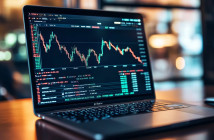The Federal Reserve holds its final meeting of the year Tuesday with inflation top of its agenda following last week’s news that consumer prices rose last month at the fastest pace in nearly 40 years.
Fed Chairman Jerome Powell has already said the central bank will discuss accelerating its wind-down of purchases of Treasuries and mortgage-backed securities. Those had been running at $120 billion a month but were pared back by $15 billion last month. Some observers believe the Fed could step up that pace at this week’s meeting to $30 billion a month.
Market analysts have already begun penciling in interest rate hikes for as early as next year, though Powell has sought to keep some distance from the “tapering” of assets and more aggressive moves on rates.
But the stickiness of inflation – which last month ran at a 6.8% annual pace – has led some to believe the Fed will be forced to move sooner to raise rates from today’s historically low levels.
“With high inflation readings heading into the new year, we now expect the Federal Reserve to speed up tapering to reach ‘zero’ by March 2022, leaving the year open for at least one rate hike, perhaps even sooner than our forecast of their first hike in September,” Beth Ann Bovino, U.S. chief economist at S&P Global Ratings.
In November, Powell acknowledged the real-world concerns of consumers that inflation is causing pain at the pump and elsewhere.
“We understand the difficulties that high inflation poses for individuals and families, particularly those with limited means to absorb higher prices for essentials such as food and transportation,” Powell said during a press conference. “Our tools cannot ease supply constraints. Like most forecasters, we continue to believe that our dynamic economy will adjust to the supply and demand imbalances and that, as it does, inflation will decline to levels much closer to our 2% longer-run goal.”
But that has not stopped politicians and others from seizing on the issue, with Republicans blaming the higher prices on President Joe Biden’s economic agenda and Democrats saying the problem is global in nature and will actually be helped by passage of their $1.75 trillion social spending proposal.
Complicating matters is the recent emergence of the omicron variant of the coronavirus. Though cases in the U.S. have so far been mild, the strain is becoming dominant in some European countries that are now imposing restrictions. Whether that causes disruptions in the global economy, as the original virus and the delta variant that emerged this summer did, remains unclear.
Views are split on how long inflation will continue at an elevated rate. Some economists think it will moderate in 2022, as comparisons with the depressed economic levels of the pandemic fade and disruptions of the global supply chain dissipate. Others think that consumer expectations for inflation are becoming embedded in the economy, in a self-fulfilling cycle that will keep the rate of inflation higher for longer.
“BCA Research’s base case is that while inflation is on a structural uptrend, price pressures will moderate next year before once again rising,” BCA Research wrote in a Monday morning client note. “However, there is no unanimity among BCA strategists on the near-term outlook.”
“A key risk to the base case view is that (barring an exogenous deflationary shock) unless the Fed is very aggressive in hiking interest rates, then inflation will be extremely hot next year,” the firm added.
Tim Holland, chief information officer at Orion Advisor Solutions, offers the view that the worst of inflation may be past.
“We think the Fed is right to assume a more hawkish stance, but we also find it interesting that, as the institution most associated with the concept of transitory inflation abandons the concept, the Bloomberg Commodity Index, which is comprised of any number of cyclically sensitive commodities, has dropped about 10% from its all-time high,” he wrote in Orion’s Weekly Wire. “Maybe, just maybe, we are near peak inflation. If so, the Fed should be able to gradually shift from an accommodative to neutral monetary policy stance, a dynamic that would be welcomed on Wall Street and should be supportive of risk assets for some time to come.”
Current high inflation is being driven by sharp spikes in the cost of energy, which was up by a third in November year over year, and food. But it can also be found more broadly in areas like housing and has shown up in wage increases. That can be harder to turn back.



